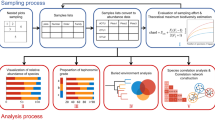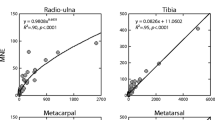Abstract
The utility of the cortex ratio first developed by Dibble et al. (American Antiquity, 70(3), 545–560, 2005) and extended by Douglass et al. (American Antiquity, 73(3), 513–526, 2008) is examined in contexts where cores rather than flakes may be transported. The cortex ratio is used to demonstrate the movement of artifacts by quantifying missing surface area, typically where it is the flakes that were removed and the cores that were left behind. In such situations, the removal of flakes with small volumes will result in the removal of relatively large cortical surface areas resulting in a low cortex ratio. However, when it is the cores that were removed, assemblages will lose greater proportions of artifact volume relative to the loss of artifact surface area. Here, we propose methods to investigate the effects of high-volume artifact removal from archeological assemblages as a proxy for human movement in addition to the cortex ratio. We apply the methods to stone artifact assemblages from the Fayum, Egypt, where changes in mid-Holocene mobility are closely linked to food production.






Similar content being viewed by others
References
Barnard, H., & Wendrich, W. (Eds.). (2008). The archaeology of mobility: old world and new world nomadism (Cotsen Advanced Seminars). Los Angeles: Cotsen Institute of Archaeology.
Bar-Yosef, O., & Belfer-Cohen, A. (1991). From sedentary hunter-gatherers to territorial farmers in the Levant. In S. A. Gregg (Ed.), Between bands and states (pp. 181–202). Carbondale: Southern Illinois University.
Binford, L. R. (1978). Dimensional analysis of behavior and site structure: learning from an Eskimo hunting stand. American Antiquity, 43(3), 330–361.
Binford, L. R. (1980). Willow smoke and dogs’ tails: hunter-gatherer settlement systems and archaeological site formation. American Antiquity, 45(1), 4–20.
Boyd, B. (2006). On ‘sedentism’ in the Later Epipalaeolithic (Natufian) Levant. World Archaeology, 38(2), 164–178.
Brewer, D. J. (1989). A model for resource exploitation in the prehistoric Fayum. In L. Krzyzaniak & M. Kobusiewicz (Eds.), Late prehistory of the Nile Basin and the Sahara (pp. 127–138). Poznan: Poznan Archaeological Museum.
Caton-Thompson, G., & Gardner, E. W. (1934). The desert Fayum. London: The Royal Anthropological Institute of Great Britain and Ireland.
Close, A. E. (2000). Reconstructing movement in prehistory. Journal of Archaeological Method and Theory, 7(1), 49–77.
Dibble, H. L., Schurmans, U. A., Iovita, R. P., & McLaughlin, M. V. (2005). The measurement and interpretation of cortex in lithic assemblages. American Antiquity, 70(3), 545–560.
Douglass, M. J. (2010). The archaeological potential of informal lithic technologies: a case study of assemblage variability in western New South Wales. Auckland: University of Auckland.
Douglass, M. J., Holdaway, S. J., Fanning, P. C., & Shiner, J. I. (2008). An assessment and archaeological application of cortex measurement in lithic assemblages. American Antiquity, 73(3), 513–526.
Edwards, P. C. (1989). Problems of recognizing earliest sedentism: the Natufian example. Journal of Mediterranean Archaeology, 2(1), 5–48.
Féblot-Augustins, J. (1993). Mobility strategies in the late Middle Palaeolithic of Central Europe and Western Europe: elements of stability and variability. Journal of Anthropological Archaeology, 12, 211–265.
Gnaden, D., & Holdaway, S. (2000). Understanding observer variation when recording stone artifacts. American Antiquity, 65(4), 739–747.
Hardy-Smith, T., & Edwards, P. C. (2004). The Garbage Crisis in prehistory: artefact discard patterns at the Early Natufian site of Wadi Hammeh 27 and the origin of household refuse disposal strategies. Journal of Anthropological Archaeology, 23, 253–289.
Hassan, F. A. (1986). Holocene lakes and prehistoric settlements of the Western Faiyum, Egypt. Journal of Archaeological Science, 13, 483–501.
Holdaway, S., & Douglass, M. J. (2012). A twenty-first century archaeology of stone artifacts. Journal of Archaeological Method and Theory, 19(1), 101–131.
Holdaway, S. J., & Douglass, M. (2015). Use beyond manufacture: non-flint stone artifacts from fowlers gap, Australia. Lithic Technology, 40(2), 94–11.
Holdaway, S., & Stern, N. (2004). A record in stone: the study of Australia’s flaked stone artefacts. Melbourne: Museum Victoria.
Holdaway, S., Fanning, P., Jones, M., Shiner, J., Witter, D. C., & Nicholls, G. (2002). Variability in the chronology of Late Holocene Aboriginal occupation on the arid margin of Southeastern Australia. Journal of Archaeological Science, 29, 351–363.
Holdaway, S., Fanning, P., & Rhodes, E. (2008). Challenging intensification: human-environment interactions in the Holocene geoarchaeological record from western New South Wales, Australia. The Holocene, 18(3), 403–412.
Holdaway, S., Wendrich, W., & Phillipps, R. (2010). Indentifying low-level food producers: detecting mobility from lithics. Antiquity, 84, 185–194.
Holdaway, S. J., Douglass, M. J., & Fanning, P. C. (2013). A new ecological framework for understanding human-environment interactions in arid Australia. In D. Frankel, S. Lawrence, & J. Webb (Eds.), Archaeology in environment and technology intersections and transformations (pp. 51–68). Melbourne: Routledge.
Holdaway, S., Douglass, M. J., & Phillipps, R. (2015). In press. Flake selection, assemblage variability and technological organization. In M. Shott (ed) Works in stone: contemporary perspectives on lithic analysis, University of Utah Press.
Kelly, R. L. (1992). Mobility/sedentism: concepts, archaeological measures, and effects. Annual Review of Anthropology, 21, 43–66.
Kuhn, S. L. (1994). A formal approach to the design and assembly of mobile toolkits. American Antiquity, 59(3), 426–442.
Lin, S. C. H., Douglass, M. J., Holdaway, S., & Floyd, B. (2010). The application of 3D laser scanning technology to the assessment of ordinal and mechanical cortex quantification in lithic analysis. Journal of Archaeological Science, 37, 694–702.
Linseele, V., Van Neer, W., Thys, S., Phillipps, R., Cappers, R., Wendrich, W., & Holdaway, S. (2014). New archaeozoological data from the Fayum “Neolithic” and a critical assessment of the evidence for early stock keeping in Egypt. PLoS ONE, 9(10), e108517.
Midant-Reynes, B. (2000). The prehistory of Egypt, from the first Egyptians to the first Pharaohs. Oxford, Blackwell.
Molleson, T. (2007). A method for the study of activity related skeletal morphologies. Bioarchaeology of the Near East, 1, 5–33.
Muller, A., & Clarkson, C. (2014). Estimating original flake mass on blades using 3D platform area: problems and prospects. Journal of Archaeological Science, 52, 31–38.
Phillipps, R. (2006). Surface stone artefact scatters of the Fayum, Egypt. Unpublished M.A. thesis, The University of Auckland, Auckland.
Phillipps, R. (2012). Documenting socio-economic variability in the Egyptian Neolithic through stone artefact analysis. Unpublished PhD Thesis, The University of Auckland, Auckland.
Phillipps, R., Holdaway, S., Wendrich, W., & Cappers, R. T. J. (2012). Mid-Holocene occupation of Egypt and global climatic change. Quaternary International, 1–13.
Rafferty, J. E. (1985). The archaeological record on sedentariness: recognition, development, and implications. Advances in Archaeological Method and Theory, 8, 113–156.
Sandford, K. S., & Arkell, A. J. (1929). Paleolithic man and the Nile-Faiyum divide: a study of the region during Pliocene and Pleistocene times (Vol. 1). Chicago: The University of Chicago Oriental Institute Publications.
Shirai, N. (2010). The archaeology of the first farmer-herders in Egypt: new insights into the Fayum Epipalaeolithic and Neolithic (Archaeological Studies Leiden University). Leiden: Leiden University Press.
Smith, B. (2001). Low-level food production. Journal of Archaeological Research, 9(1), 1–43.
Thomsen, K. (2004). Numericana. http://www.home.att.net/~numericana/answer/ellipsoid.htm. Accessed 1 March 2008.
Turq, A., Roebroeks, W., Bourguignon, L., & Faivre, J. (2013). The fragmented character of Middle Palaeolithic stone tool technology. Journal of Human Evolution, 65, 641–655.
Wendorf, F., & Schild, R. (1976). Prehistory of the Nile Valley. New York: Academic.
Wendrich, W., & Cappers, R. T. J. (2005). Egypt’s earliest granaries: evidence from the Fayum. Egyptian Archaeology, 27, 12–15.
Wendrich, W., Taylor, R. E., & Southon, J. (2010). Dating stratified settlement sites at Kom K and Kom W: fifth millenium BCE radiocarbon ages for the Fayum Neolithic. Nuclear Instruments and Methods in Physics Research B, 268, 999–1002.
Wendrich, W., Taylor, R. E., & Southon, J. (2011). Dating stratified settlement sites at Kom K and Kom W: fifth millennium BCE radiocarbon ages for the Fayum Neolithic. Nuclear Instruments and Methods in Physics Research B, 268, 999–1002.
Wengrow, D. (2006). The archaeology of early Egypt: social transformations in North-East Africa, c. 10,000 to 2,650 BC. Cambridge: Cambridge University Press.
Wengrow, D., Dee, M., Foster, S., Stevenson, A., & Bronk Ramsey, C. (2014). Cultural convergence in the Neolithic of the Nile Valley: a prehistoric perspective on Egypt’s place in Africa. Antiquity, 88, 95–111.
Wenke, R. J., Long, J. E., & Buck, P. E. (1988). Epipaleolithic and Neolithic subsistence and settlement in the Fayyum Oasis of Egypt. Journal of Field Archaeology, 15, 29–51.
Whittaker, J. C. (1994). Flintknapping: making and understanding stone tools. Austin: University of Texas Press.
Williams, M. A. J. (2009). Late Pleistocene and Holocene environments in the Nile basin. Global and Planetary Change, 69, 1–15.
Acknowledgments
Work reported here was supported by the Royal Society of New Zealand through a Marsden grant, by the National Geographic Society, and by the University of Auckland. Permission to work on the Fayum material was provided by the Egyptian Supreme Council of Antiquities to the UCLA, Groningen University, University of Auckland Fayum Project (URU). We thank Willeke Wendrich, Matthew Douglass, Sam Lin, and Josh Emmitt for their comments on the paper. Briar Sefton drew the figures.
Author information
Authors and Affiliations
Corresponding author
Rights and permissions
About this article
Cite this article
Phillipps, R.S., Holdaway, S.J. Estimating Core Number in Assemblages: Core Movement and Mobility During the Holocene of the Fayum, Egypt. J Archaeol Method Theory 23, 520–540 (2016). https://doi.org/10.1007/s10816-015-9250-2
Published:
Issue Date:
DOI: https://doi.org/10.1007/s10816-015-9250-2




